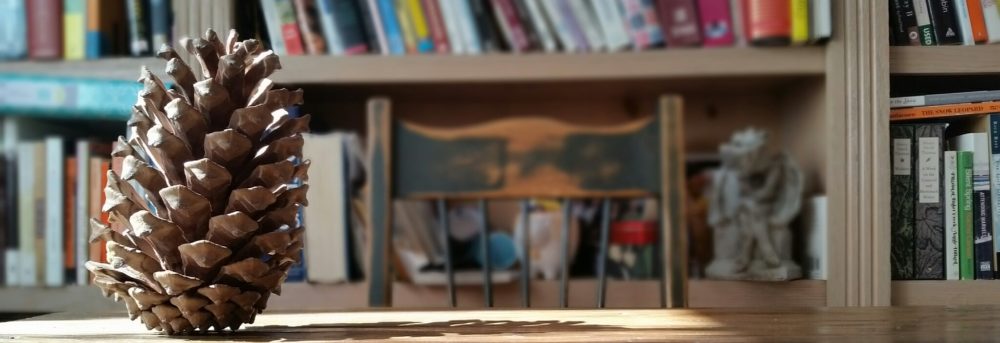Valdez, AK. Elevation 98 feet. Monday July 22, 2024-High 50s/Overcast and rainy. Sunrise: 4:55 am/Sunset: 10:46 pm. 17 hours and 50 minutes of daylight.

The small boat was painted greenish blue with an outline of a seal sketched in black on the starboard side. It was docked in a slip at the Valdez harbor and at 23 feet was a little longer than the Shasta trailer we camped in when I was a kid. We found this unusual lodging on Air BnB and booked it for two nights. It slept three and didn’t have running water.
Before we boarded the boat, we took in the view and checked out the harbor facilities. It was late Sunday afternoon, and the fishing boats were coming in. Most seemed to be personal or charter boats.
Near the harbormaster’s office was a public area with long counters and overhead water hoses with spray attachments for fish cleaning. Heads, guts, and bones were washed onto a slide area that ended in a chute that emptied into a container in the harbor. A row of attentive gulls and crows (some of my only bird sightings while in Alaska) kept a close watch on the activities ready to snatch whatever they could.
A whiteboard hanging nearby kept a daily and overall tally of the summer’s fish derbies which included halibut and silver salmon.
The harbor and adjacent village are situated on the Valdez Arm of Prince WIlliam Sound (PWS) in the northeast portion of the sound. We came in over the Chugach Mountains via the Richardson Highway and in the final thirty miles we crossed the summit of Thompson Pass (at 2805 feet it averages 500 inches of snow per year) and saw waterfalls and glaciers at almost every curve in the road.
My reading during the trip included the memoir The Heart of the Sound: An Alaskan Paradise Found and Nearly Lost by Marybeth Holleman. She describes the location of Prince William Sound:
It is a place of convergence–the geographic center for Alaska and the Pacific, where the Arctic to the north, Aleutians to the west, and Inside Passage to the south all intersect.
Holleman arrived in Alaska a few years prior to the Exxon Valdez oil spill and spent those years and many after the disaster kayaking or boating on the sound and camping on its beaches. The spill spread oil throughout the sound killing thousands of fish and animals. Her story recounts not only the toll on marine life but also on the humans who lived, worked, and recreated in this unique and pristine environment.
The timeline (see below) provided by NOAA was thumbtacked on a bulletin board at the harbormaster’s building. It shows the status of PWS species recovery 25 years after the spill. Another ten years has now passed, and I wonder if anything has changed especially for those on the bottom row.

In the evening, we returned to the boat where we had loaded our backpacks and suitcases. The sunny evening and a big salmon dinner kept us going even though we were all fighting colds that I caught first and had now moved on to Dave and Dad. We found the accommodations challenging but not impossible. A bench, one folding chair and, a big cooler with four cupholders was our living room. An extension cord gave us all a place to charge our phones and one bright light, but we never did figure out how to turn on the string of party lights.
By morning fog and rain had moved in and weren’t budging. Getting out and exploring wasn’t appealing so we went from a coffee shop to the library to the visitor center to a Chinese restaurant for dinner trying to stay warm and dry. I connected my phone to the public Wi-Fi at each place we stopped but was never able to upload the photos for my previous post about fireweed and white spruce. I finally conceded defeat and decided to finish these posts once I returned to my dry dining room table.
Back on the damp boat for our second night we consoled ourselves that it was still better than sleeping in a tent. And I said, “If we survive this, we’ll look back on it as an adventure.” But I’m not sure I convinced anyone. Everyone’s spirits seemed to lift a bit the next morning when we carefully disembarked the boat through its small door for the last time.
I confess I was also beginning to feel melancholy about the trip. Since our first brief trip to Alaska back in 2000 I had looked forward to returning, hoping that we would be able to make the trip with Dad, and now it was almost over.
So, it wasn’t long before I began thinking about a return visit somewhere down the road. I’m still not sold on the Inside Passage cruises that are so popular but maybe a flight to Anchorage and another trip on the Alaska Railroad–south to Seward with a with a stop in Whittier to get a look at the other side of Prince WIlliam Sound. And maybe this time I’ll see some tufted puffins.










